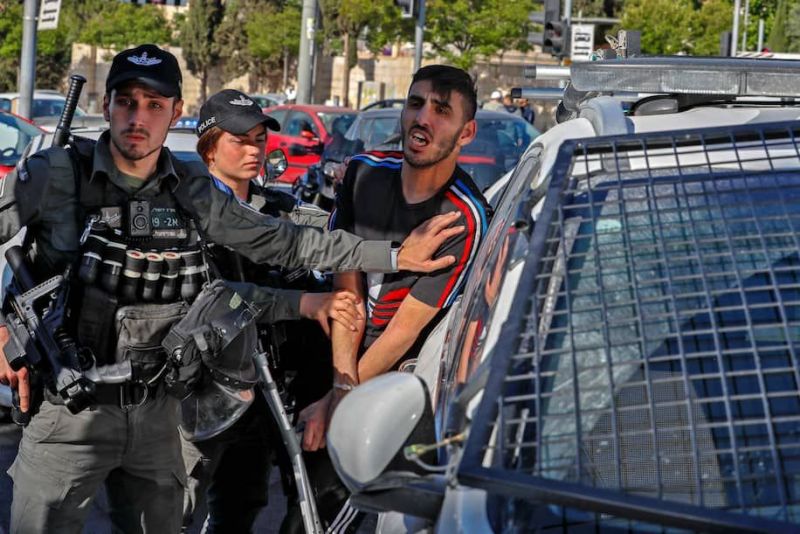
It is no coincidence that the latest episode in the hundred-plus year war on Palestine should erupt over the issues of Jerusalem and refugees. Both are entwined with the history of Israel’s efforts to dispossess and displace the Palestinian people. In recent weeks, Israel’s brutal actions in and around Jerusalem’s al-Aqsa Mosque, and its attempts to forcibly displace Palestinians in the nearby neighborhood of Sheikh Jarrah, were triggers for another violent, asymmetrical confrontation (illustrated by the greater than 10-to-1 disparity in casualty figures). Both issues go to the core of this one-sided struggle against dispossession, and both have long been diligently swept under the rug by U.S. policymakers charged with bringing it to an end.
These are not “riots” or a “real estate dispute,” as the endlessly repeated Israeli talking points would have it. The context for these events in Jerusalem, in Gaza and elsewhere in Palestine and Israel is summarized in the words of the Israeli deputy mayor of Jerusalem, Aryeh King, who recently stated that the Sheikh Jarrah evictions were “of course” part of Israel’s plan to place “layers of Jews” throughout the eastern half of the city. The aim, he said, was to “secure the future of Jerusalem as a Jewish capital for the Jewish people.”
This process of “Judaization” (the official Israeli term), based on the inexorable logic of settler colonialism, has operated through the confiscation of homes and land and the displacement of their Palestinian owners inside Israel since 1948, and since 1967 in East Jerusalem, the West Bank and the Golan Heights.
This is the logic behind marches by heavily armed Jewish religious nationalist settlers through Arab neighborhoods of Jerusalem, protected by Israeli security forces as they attack and intimidate residents. It is the logic behind Israeli police forcibly preventing Palestinians from enjoying Ramadan nights at the Damascus Gate plaza, one of the few open areas around the Old City. It is the logic behind attacks by soldiers on worshippers at the al-Aqsa Mosque compound night after night during the last days of Ramadan, including firing stun grenades and tear gas canisters into the third-holiest mosque in the Islamic world. What would the global reaction be to a similar attack on worshippers inside a major church or synagogue on a religious holiday?
What is at work here is the logic of the 2018 law that raised a central tenet of political Zionism to the level of a constitutional principle: that only the Jewish people have the right of self-determination in the Land of Israel. Since 1967, Israel has been extending its sovereignty over the entirety of former Mandatory Palestine, between the Jordan River and the Mediterranean Sea, in an inexorable process of creeping annexation. The 2018 law, which established “Jewish settlement as a national value,” implies that the Palestinian people have no national rights in their ancestral homeland, and that their dispossession is a legitimate and necessary Israeli endeavor.
This discriminatory logic explains why the Israeli state puts its powerful repressive apparatus at the disposal of religious extremists as they expel Palestinian residents from their homes by claiming prior ownership in Sheikh Jarrah. Meanwhile, it bars consideration of the ownership claims of these same residents to their properties confiscated after they were driven from their homes in Haifa, Jaffa and West Jerusalem in 1948.
This crisis has deflated an important myth. This is that the Palestinians are divided, dispirited and demoralized, and should capitulate to whatever terms Israel offers them. The Palestinians may be politically divided, but whether in the West Bank, Jerusalem, Gaza, inside Israel or living in the diaspora, they are subject to the same iron processes of dispossession and legalized discrimination that were always inherent in a project to create a Jewish-majority state in what was, and once again is or will soon be, an Arab-majority country. The unity of their resistance to dispossession and erasure has been illustrated by protests in every part of the country, whether in Jerusalem, in the mixed towns of Lydd (Lod), Ramle, Acre or Haifa, or in the Gaza Strip.
As long as the United States ignores the bedrock principle of absolute equality in Palestine/Israel — which it has never advocated — it will continue to be part of the problem rather than part of the solution. U.S. representatives speak of Israel’s right to self-defense. What of the right of the Palestinians to resist their 70-plus years of dispossession?
A sustainable solution, whether based on two states or one, must enshrine absolute equality of rights for both peoples, including collective, national and political rights, as well as religious, property and civil rights. Until the United States accepts this principle and acts to enforce U.N. resolutions it voted for, cqwhether on Jerusalem or Israeli colonization; until it vigorously enforces its laws on the strictly defensive use of American weapons and regarding the “charitable” status of American 501(c)(3) groups that finance settlement activities in violation of international law, it is not a neutral actor: It is an active party to the dispossession of the Palestinian people, alongside Israel.
Rashid Khalidi is Edward Said Professor of Arab Studies at Columbia University and author of “The Hundred Years’ War on Palestine.” He was an adviser to Palestinian negotiators at Madrid and Washington from 1991 to 1993.
